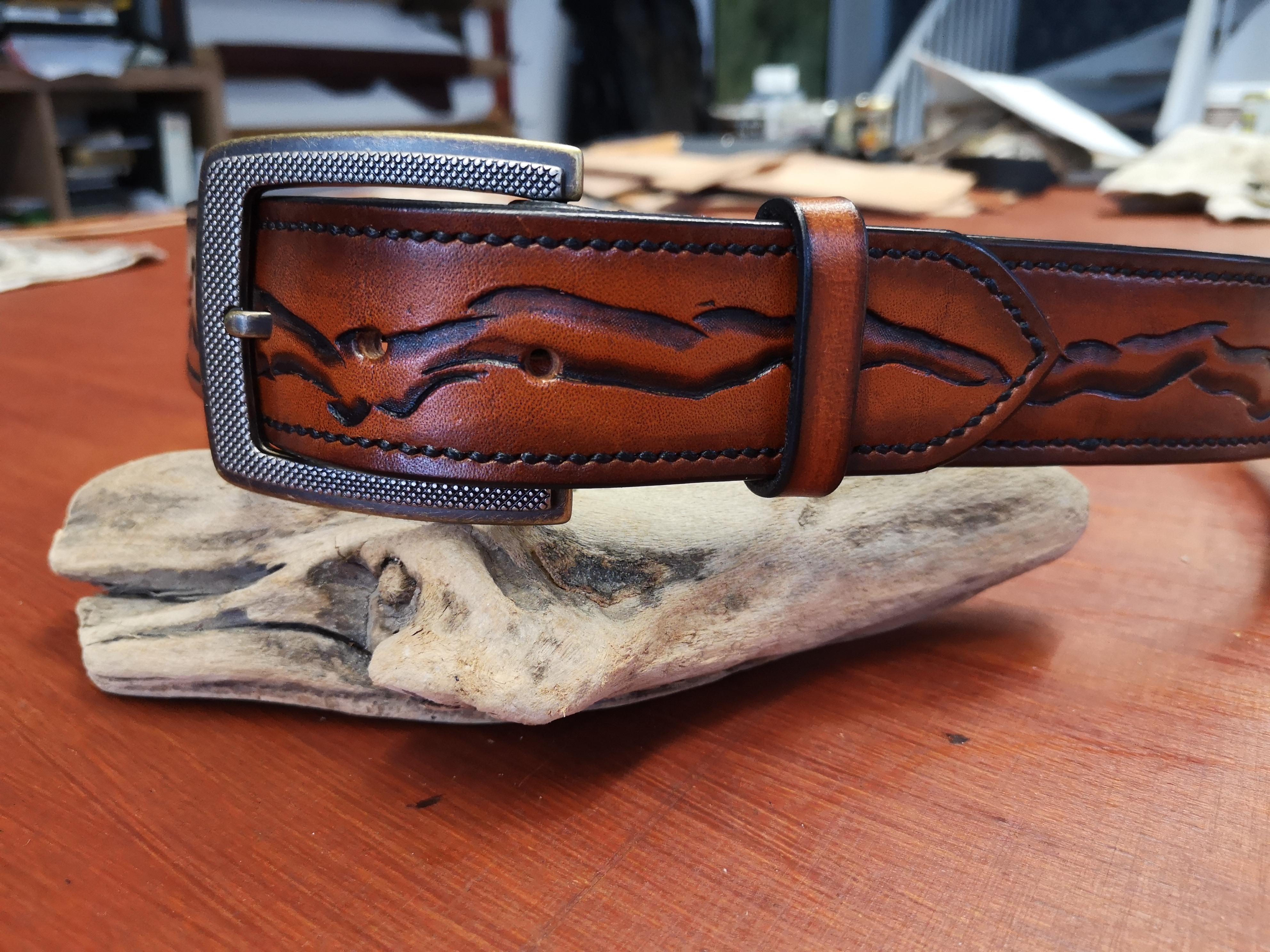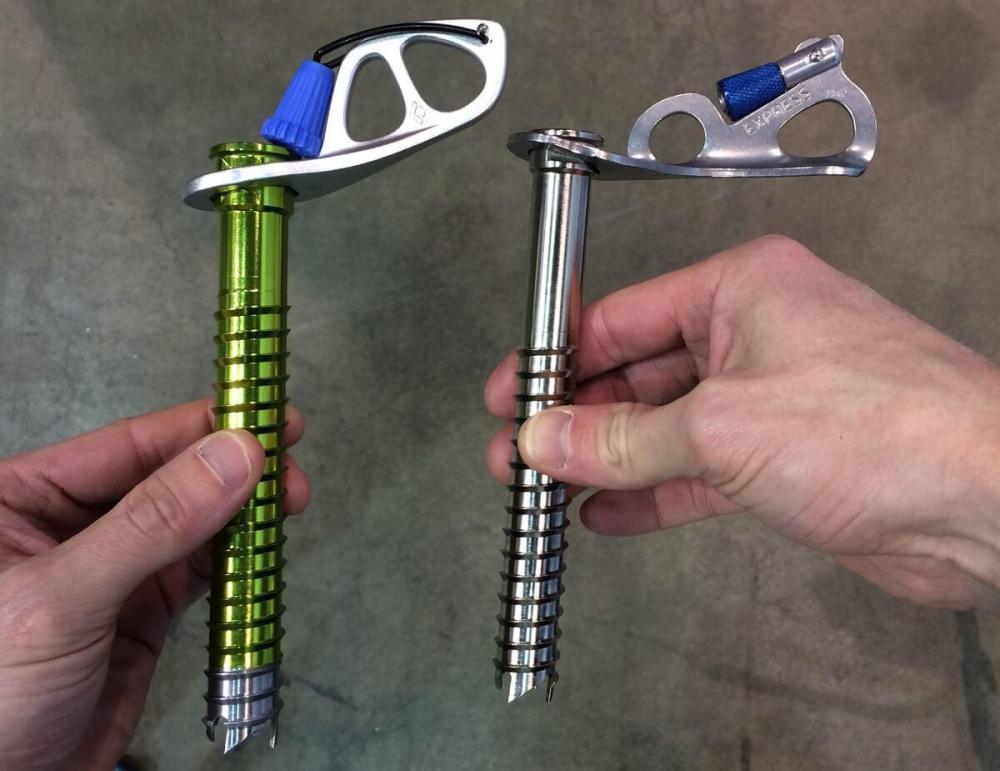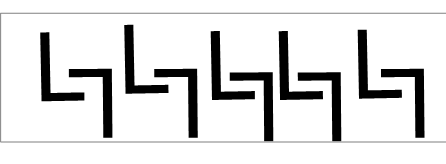-
Posts
122 -
Joined
-
Last visited
Content Type
Profiles
Forums
Events
Blogs
Gallery
Everything posted by HondoMan
-
Ice screws...... and a toolroll. Had a customer in the shop yesterday and he wants a toolroll for this 'L' shaped tool. The issue at hand is the rolling aspect of this wee toolroll. Due to it's shape, I cannot find a means to make it roll properly. I've sketched out various styles, but nothing is coming into that 'wee wet noodle between mah ears' that will make this roll. Perhaps this is a non-starter. The type of roll I end up with ends in more of a stacking style... Also, to add insult to injury, 9 of these are 160mm in length and the 10th one is 200mm. The one that is 4cm longer is truly unhelpful. Perhaps one of you have done something similar or have an idea? Cheers!
-
Aye.... mah gran referred to our cousins in the colonies as gummies. Never knew why, til she passed. Mah auntie told me it was due to the chewing gum. As a wee bairn I was rather daft. I would make a wee remark about the deep fried, but FFS, in my homeland, we're known to deep fry chocolate bars. Never had one and never will. Bawbaggery!
-
This is one of those leather mysteries that will stay such I think. Much like the ever mystical left-handed leather tools.... Stockists have on offer, what they think sells. I suppose. They offer a wee press, but few fittings. No one carries a complete set of fittings for poppers, all types of rivets and eyelets. But in studying this, I discovered most, but not all presses have a base size of 12mm and the upper threaded part, 6,3mm. Seems I'll have to work with that. Found a stunning old Rodus Spindle Press, completely refurbished for 100€. I do love old tools. Now it will be a matter of finding proper fittings and these are scattered around the Interwebs, all over the EU. Will take time, but such is life. At least I have a solution. Cheers!
-
How interesting to read on the posting matters.... gave me a wee laugh. Germany is no different folks. I ordered something from Kempten, Germany, about 20min north of me. It was mailed, if I recall on the Monday. I was sent an email with the tracking number. A few hours after the email was sent, I looked at the DHL website to see where it was. It traveled 70km north of Kempten. Had a wee nighttime pause, then made the 90km trip south to me - the same bloody day! Aye, I did have it the day after it was posted, but FFS, why did it need to travel north, just to come back south? One might think the postal service here is still run by the government.... disorganised and senseless!
-
A wee update on Yangtools. In a leather-working FB group, a lad posted a photo of his recent purchase. A lefty plough gauge! That's extremely rare. Indeed. It arrived yesterday, so I asked him to let me know how he gets on with it in the following weeks. He doesn't have a proper website - only Instagram. That concerns me, greatly. Also, the gauge only goes to 8cm, I believe. No easy to see from the few photos. But a lefty gauge is interesting. No one else makes one.
-
The don't have machines on offer. Only rivets and poppers.
-
A wee look at their website looks promising. I'll send them an email in the morning. Cheers!
-
Right then, over the past few years I've been searching for a proper press. I think I've physically seen one, but never used. I've been doing so by hand. Aye, with brass rivets and cheap poppers one must use caution. I keep in stock rivets size 4mm through 11mm and poppers size 8, 10, 12, 14, 15 and 17mm. In my search I'll find a company who has a press on offer but offers fittings for half of what I need. I would image fittings that suit one press, won't suit another. Do any firms in the US carry a spindle or handle-down press that would suit my needs? Thanks in advance and happy Easter.
-
Servus Marco und herzlich Willkommen, I hope that if you are wanting to make 'authentic' items for the Mittelaltermärkte and fests, that you are not using that sewing machine from the cellar. Just a week bit of humour. Welcome to the website.
-
@Rahere, have an idea what you're on about and I appreciate your input, but would rather no do that. It puts stitch holes in the leather before tooling and dyeing, which can be problematic. Cheers!
-
Right then, have the odd (to me at least) order for a man's bag. The request is for the back and cover (only and one piece) to be basketweave stamped. The length or height of the front piece is 27,5cm. Three gussets on this bag for a combined 20cm. The length of the cover need be half down the front (13,5cm). Including the leather thickness, I've calulated 62,5cm. A length of 62,5cm will fall short. The problem I'm on about is the wee curve across the top of the gussets. That is an additional length to the piece and my maths seem to be not aiding me at present. I get the very rare request for a tooled bag (more belts than anything). Normally I simply cut the back-cover piece long and trim off the excess. That's a non-starter this time. It need be spot on or as exact as possible. One centimeter short or long will be fine. Suggestions on a solution to this? Cheers!
-

How Much To Charge For A Small Laptop Bag?
HondoMan replied to AzShooter's topic in Marketing and Advertising
This is a very subjective matter. Only you can honestly answer such a question based on numerous factors. The first being the most important. What do you honestly think your skill level is and is worth? Compare what you make to others. Is your stitching, skiving, pattern making, dying, tooling, etc...stunning or does it need wee tuning and improvement? Is it consistent - always. What is your cost of living or overhead? What are others in your area charging per hour? There are simply too many factors and only you can be the end decider of what your time is worth. -
@Chris623 Tooling and stamping. Get yourself some tape. I use a double-sided carpet tape. Tape the leather and fix it to a piece of cardboard. This will stop the stretch. You can leave it when dyeing the leather. Dyeing can change the size of the leather as well and the tape stops the dye from showing on the flesh side, if one does no plan to dye the flesh side. The cardboard will also allow one to hammer a wee harder to make a better imprint from the stamp, beveler, etc. This is handy with thicker leathers. Corium? Google leather grains and corium. It's a layer of the leather. Corium is the looser fibres closer to the flesh. When your budget allows, buy full grain only. Good on protecting the blade. Well done!
-
Your Camo stamps are huge, but it's no bad for your first sheath. Chris, Don Gonzales uploaded a video about serpentine borders. Give it a wee watch and you'll see what I'm on about with starting at the corners and working towards each. On the other matter, what I was on about and what would have given an easier go on the camo stamps in the corner. Looking at the back of the sheath, your maker's mark is in the center with a 'half circle' down and up. My suggestion was to switch them. This would offer easier corners, perhaps. Another few suggestions. The front: Your stitch line.... start at the corner and top and work towards the middle. Seems you cut one hole in half (at the top). Also, don't tool to the edge (top). It's no asthetically pleasing. That edge should have a border of some type. Do you have a welt between the front and back? Next, this is a personal thing to me, but I do no put screw rivets or press snaps on top of the blade unless the sheath is to be lined. It will scratch the blade and if the metal in that wee screw is poor quality, it could rust. The back: It appears you have top grain or the junction with corium. See how the flesh side looks rough and loose? Use some saddle soap to press those fibres down. That or use oil dye to dye the entire thing and use a good top coat. Lastly, a wee trick on your tooling window: If you bevel the edge to be tooled and then....use the camo stamp, it will look stunning. More importantly, your camo stamps will be straighter and deeper. Again, you did well for your first go.
-
Chris, start in those corners first. You can overlap the camo stamps in corners. Once your corners are done, work from one corner to the other. As always, get some wee scrap pieces and practice before you start on the actual sheath. As a suggestion, what might suit and be a wee easier for you. Rather than have your mark between ( mark ) try.... ) Mark ( You might find your camo stamps have a proper fit and look.
-

Making a card holder template in Autocad (Video clip)
HondoMan replied to Danne's topic in How Do I Do That?
All I've ever done as well mate. Done in no time and no involvement of using a computer. Just a wee coffee and give it a go. -
From experience, it's a non-starter. I no longer take internet orders, emails, texts, or phone calls which involve measuring, be it dog collars, belts, armbands or cuffs, etc. Kenneth, if you decide to have a wee go, it will not prove well. I can near on guarantee that the client's ability to measure will be different from yours. I tried explaining to customers countless times, and it very rarely is accurate. It is not necessarily the fault of the client. I have numerous rules and tailor's tapes in me shop and nearly all are different. Perhaps the first 10cm are identical, but then it all goes to hell. Also, some will 'cheat' and simply tell you that their belt size is 95, for example, since it appears on the inside. For some companies, that means to the end of the leather and some meaning to the end of the buckle frame. If you chose to take an online order, prepare yourself for 'the belt is too long or too short'.
-
Goodness.... Pricking irons are to be used in conjunction with an awl. One simply makes wee 'pricks' or marks on the leather and then using an awl, sews the two pieces together. A diamond chisel is ment to combine a pricking iron and awl. One can punch through both pieces of leather (depending upon the combined thickness). You need to spend time watching Nigel Armitage videos to get a better grasp on this topic.
-
What exactly did you buy for chisels? Either tell us or post photos. From your photo, it appears more pricking iron than chisel.
-
@KennethM, I make several belts per week and this seems to suit near on every customer. There are various things you'll need to figure on your own. Sorry, I only use the metric system. I did learn the imperal system years ago in school, but don't use it enough to know what you would need here. Men's belts have roughly 2.5mm between holes and women 2mm. Kids and teenagers can be 2mm or 1.5mm. Take into account the body shape and size. Stay with 5 or 7 holes. Other amounts offer and unprofessional appearance and it is problematic if you offer an even number. The center hole is the current size. It is best to have the client offer their current belt - with holes! These woven type belts are very difficult to get a proper measure. Measuring the current belt. If one googles how, there will be several methods. There is only one proper way. Laying the belt flat and as straight as can be, measure from the currently used hole to the point where the tine and buckle frame meet. This is how the belt is worn. Do not measure to the end of the frame or to the end of the leather. Buckles come on various lengths, so measuring to the end of the buckle or end of the leather do not offer the current length. Also consider the thickness of the current belt and the leather you will use to make a belt. This will need to be considered for the new belt. It may be 1mm or less. Also, ask the client how that current hole is for them. Is it a wee tight, loose or perfect. If too thight, perhaps 5mm additional might suit. Same for too loose. The idea is when they put on their new belt, the middle hole need to used and should be comfortable. Not too tight or loose. If the client wants a 5 hole belt, the tip of the belt to the middle hole need be 15cm. If it is a 7 hole belt, then it will be 17,5cm to the center hole. I tend to add 8cm for the bend back (part to be sewn where the buckle is). That is simply my choice. Shorter can do as well, but not too short. For a plain belt, the stitching may be the only decoration to the belt and a longer bend back can offer a stunning appearance with a slight contrast in thread colour. On that, do not stitch across the belt. This will weaken the leather at the buckle. From the buckle, stitch along the edge to the end of the bend back. Make your stitch line 4mm from the edge. 3mm is too close to the edge and your irons or awl will cause the edge to have a 'lumpy' appearance. More than 4mm will cause the leather at the bend back to open at the edge. Also, don't use too thin a thread. I tend to use either 8mm or 1mm thread. 6mm is ok. Less than that is simply too thin. From the hole the buckle tine go through, come back to the tip of the belt about 2,5cm and skive the belt to the end of the bend back. The reason, if the leather for the belt is 3,5mm thick, if this is not skived down, one will have 10,5mm of leather at the buckle (bend back area plus the tip of the belt. That's a lot of leather. Skive down to about 2-2.5mm. Use caution not to make it too thin. If you are using a D shaped buckle or single frame, you will need a keeper. How wide you make it and secure it is your choice. Sewing it into the belt is best, but can prove difficult for a beginner. What is important is the distance from the buckle to the keeper. Too far away and the trouser belt loops ge in the way. So, from the edge of the long hole for the tine, come back 3cm towards the tip of the belt or 3cm away from that long hole. This distance will be perfect. Lastly, if you have a 40mm wide buckle, you want 38mm wide leather. For a 35mm buckle, 33mm wide leather, etc. If you are adding a maker's stamp or other tooling, consider also how the client wears their belt. Traditionally, men put their belts on to the left and women to the right, but today that does not really hold true. Either ask or look. This is important as you wouldn't want your logo or tooling to be upside-down. It is also important if you have a buckle with some type of design or logo. These are generally meant for people who slide their belt on to the left. If such a buckle is for someone who wears their belt to the right, you might wish to mention this. Hope that helps get you sorted. Don't forget to post photos of your work. Would like to see your first few belts...soon!
-
Like @mike02130 I prefer the blanchard. They are consistent and affordable and the blades are hand forged and easily polished. More importantly for me is the handle....tiny. I don't want to pressure push the awl with me palm, but simply holding it with me fingers.
-

Two-tone bridle belt
HondoMan replied to Prusty's topic in Purses, Wallets, Belts and Miscellaneous Pocket Items
@Prusty, one last wee word of praise. Seems you are on early days in leather and aside that you did a right grand job on the sewing. It appears you used an awl and going through three layers of leather, not withstanding the keeper, the back side of your stitching is near on perfect. No easy feat mate. Well done! -

Two-tone bridle belt
HondoMan replied to Prusty's topic in Purses, Wallets, Belts and Miscellaneous Pocket Items
I second that. Gets on me last tit to no end. Prusty did a right good job. The amount of people who bring belts into the shop to have a rivet or screw replaced is maddening. Best of all are the rivets that have fallen completely out because the hole stretched. The average customer simply doesn't grasp they bought a rubbish belt, made from rubbish leather made on the cheap. A sad state of affairs. -

Two-tone bridle belt
HondoMan replied to Prusty's topic in Purses, Wallets, Belts and Miscellaneous Pocket Items
A smart look. Truly. A good design. And mistakes are normal, allowing us to know where to improve. Me only critique is the buckle holes. The bottom photo.... that hole where the tine goes, should be 15cm from the tip of the belt, if having a five hole belt. With 7 holes, then 17,5cm. A six hole belt, whilst nothing wrong, is a bit odd. If the wearer gains a stone at Christmastime , the tip of the belt will be under the keeper and most like won't stay. Again, I do like the design and colour matching. A nice job! -
I have me own shop. I am fortunate enough to have retired early (at 46) and was able to turn a hobby into full time employment. Been at it full time for about 5 years. It's perhaps 40% repair and 60% new items. I live in a rural area of southern Germany (Bavaria) at the foot of the alps. Loads of knife sheaths to make and repair. I turn down quite a bit, due to shite bags that are worth 20€ and no worth the time or money to repair. I'm in the highstreet and me flat is above the shop (attached), which makes it affordable. To be honest, I think this was pure luck on the shop-flat and the location. This would never go in a large city. Too expensive and too much competition.





